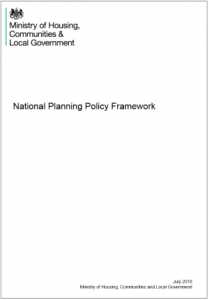 The IHBC has warmly welcomed the new Historic England (HE) briefing on the government’s post-NPPF revision guidance on built and historic environment and conservation planning, while adding some further points also worthy of note.
The IHBC has warmly welcomed the new Historic England (HE) briefing on the government’s post-NPPF revision guidance on built and historic environment and conservation planning, while adding some further points also worthy of note.
IHBC Policy Chair Roy Lewis said: ‘As noted previously, it is helpful that the terminology in the government’s revised guidance reflects the words used in the statute and in the NPPF, and this is captured in Historic England’s useful briefing.’
‘There are also some other points that may be of particular note, for example in future redrafts:
- The section headed ‘What is meant by the conservation and enhancement of the historic environment?’ doesn’t actually provide any guidance as to what is meant by ‘enhancement’. There is however a reference to recording, which doesn’t seem entirely relevant in this section.
- The new section headed ‘When is securing a heritage asset’s optimum viable use appropriate in planning terms?’ states:
‘Area-based’ designated heritage assets such as World Heritage Sites and conservation areas will not themselves have a single use … Therefore, securing the optimum viable use of the area-based asset as a whole is not a relevant consideration in assessing the public benefits of development proposals affecting such heritage assets’.
However, the section makes no reference to registered parks and gardens, which are capable of a single use and are capable of having an optimum viable use. This is an unfortunate omission which will probably lead to further confusion and disagreement.
- Under the heading ‘How can the possibility of harm to conservation areas be assessed?’, consideration has to be given to the relative significance of any part of a conservation area affected by a proposed change to the contribution of that part to the significance of the conservation area as a whole. This works against large urban conservation areas, such as those that embrace whole historic towns and works in favour of small ones. The guidance implies that LPAs with extensive CAs should consider re-designating them as multiple CAs made up like a jigsaw puzzle. The impact of any harmful development proposal on the smaller designated segment would then be likely to be far higher in relation to the designated area as a whole. Such disaggregation would of course be ridiculous. The sensible approach would be to have a policy that actually works in relation to conservation areas, whether large or small (as recommended by IHBC in its consultation response on the revised NPPF).
HE writes:
- The Government published an updated Historic Environment section of the Planning Practice Guidance (PPG) on 23 July to reflect the changes made to the National Planning Policy Framework (NPPF) since the 2012 edition.
- A large number of other sections of the PPG have also been updated, but this briefing focuses on the main changes made in the Historic Environment section (previously Conserving and Enhancing the Historic Environment), structured by PPG section….
- The majority of the PPG text is unchanged.
- The more significant changes include:
- Clarity regarding the definition of heritage assets (they are now clearly classified as either designated or non-designated, which provides greater certainty as to the NPPF policy to be applied), and how they are identified (the ways in which non-designated heritage assets can be identified now specifically include neighbourhood plans and neighbourhood planning bodies).
- Greater discussion of the nature of harm, including clarity regarding total loss, how harm should be articulated, and more information on assessing potential harm to conservation areas.
- Additional text on the assessment by applicants of significance and the impact of proposals on that significance.
- Reinstatement of the definitions of the ‘four interests’ (originally set out in Planning Policy Statement 5 (2010).
- Clarification of the ‘where appropriate’ provision in the NPPF, in relation to optimum viable use.
- Clarity regarding the status of World Heritage Site buffer zones as part of setting, and the related consultation requirements.
- Wherever there is discussion of particular types of designated heritage asset, the coverage has been extended to cover all such asset types.
- There has also been some reordering, there are fewer uses of ‘should’, and references are now generally made throughout to the ‘development plan’ rather than ‘local plans’, and to ‘plans’ or ‘plan-making bodies’ rather than ‘local authorities’…
See HE’s briefing
Read the full government guidance
See the previous version of the guidance
For more on the NPPF revision see the IHBC NewsBlogs
See the IHBC’s joint Conservation Professional Practice Principles
See more background to the IHBC’s joint Conservation ProfessionalPractice Principles on the IHBC NewsBlogs
To see the practitioners’ context to the Conservation Professional Practice Principles follow the links to our ‘Recognised standards and guidelines’ on the IHBC’s Toolbox

